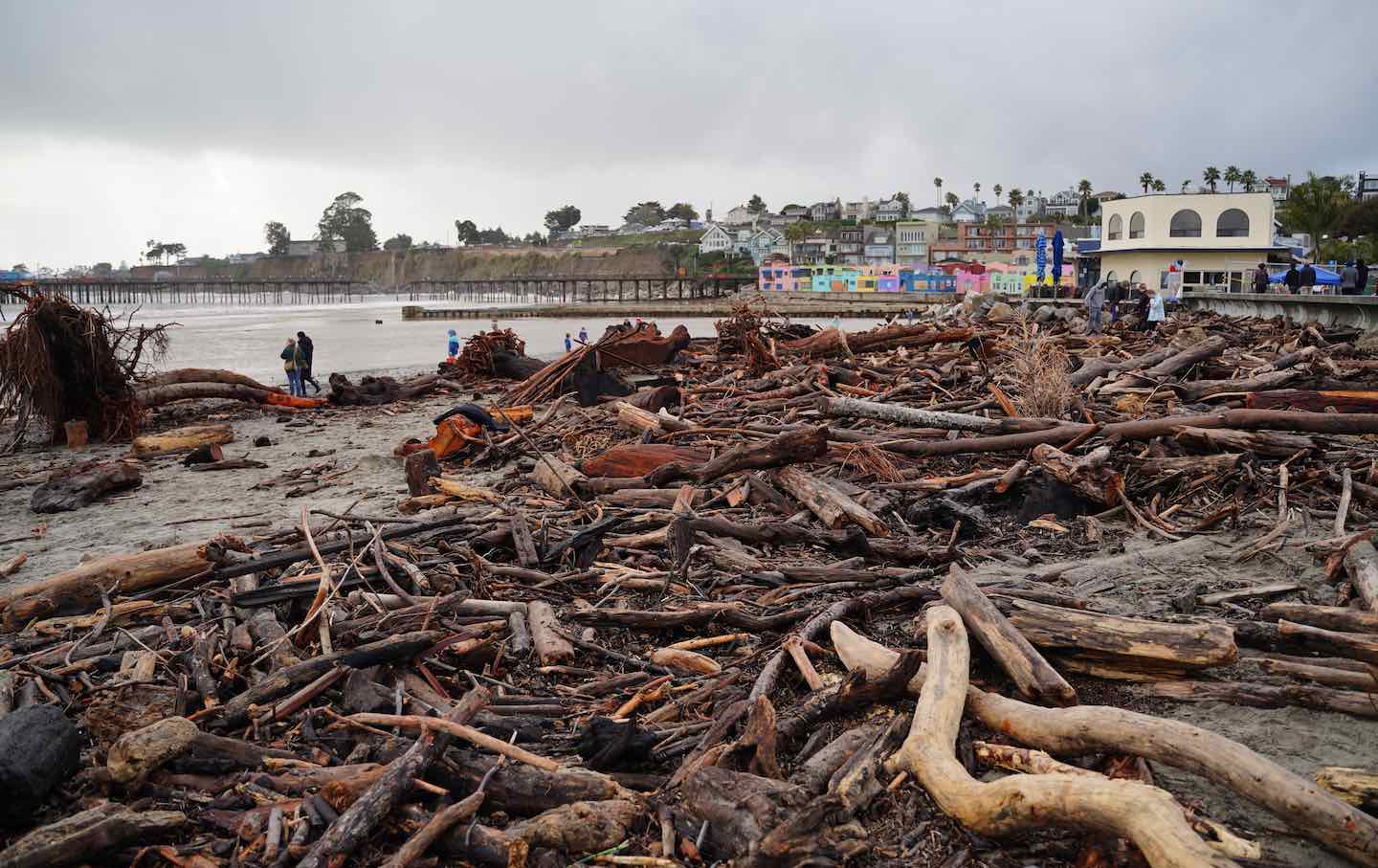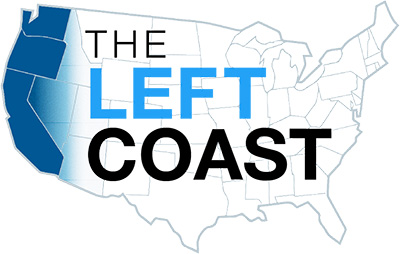
Driftwood storm debris on the beach in Capitola, Calif. Powerful storm systems have slammed the state since December 2022.(Michael Ho Wai Lee / SOPA Images / LightRocket via Getty Images)

Today, for the first day in more than three weeks, the sun has been shining brilliantly in a cloudless blue sky above Sacramento. Everything seems calm again, the brutality of the weeks of storms already but a memory. The fierce winds that bedeviled the city, the drenching rains, the thunderstorms, the power outages, the flooded highways, even Sunday’s near-biblical deluge of hail, all seem somehow strangely distant. When the sun shines in the Golden State, things start to feel good again remarkably quickly.
Except, of course, nothing is really quite normal.
Flying back on Sunday afternoon from a trip to Southern California, I could see mile upon mile of floods out of the plane window as we approached Sacramento. Washed-out rural neighborhoods; lakes that, until recently, didn’t exist; roads with muddy waters lapping at their edges.
Walking through Land Park, one of the city’s tonier neighborhoods, on the annual Martin Luther King Day march yesterday, one could see the devastation caused by the freak weather: great trees, that have spent the last hundred-plus years solidifying their status, down by the dozens. They rested at odd angles in roads, on driveways, in yards, in same cases on houses or cars, strewn like carcasses throughout the acres of parkland.
Already, the cost—in terms of the economic damage directly caused by flooding and downed trees, and the economic loss caused by the seizing up of parts of the California economy and transport systems—is estimated to be in the $34 billion range. This will, almost certainly, rise in the coming days and weeks as insurance claims continue to pour in and as damage from flooded rivers and creeks continues to escalate.
True, compared to Hurricane Katrina and the devastation wrought on Louisiana, and on New Orleans in particular, this is small change. The estimates for the cost of that disaster fluctuate, depending on the modeling, but best-guess numbers suggest it caused up to $200 billion of damage. California’s loss is also but a fraction of the cost inflicted on Florida by last year’s Hurricane Ian. That storm cost insurers at least $67 billion and cost the state tens of billions of dollars more in economic losses.
Yet, the weeks of flooding cannot be considered in isolation from other recent weather-related disasters. While California, historically, has had massive, prolonged deluges that have flooded large parts of the state, in particular the Central Valley, the dynamics of these mega-storms have likely been worsened by human-induced climate change—as a stunningly prescient report in The New York Times from August of last year detailed.
The American West’s weather-related vulnerabilities have long been drought, fires, and floods. All of these have been magnified in recent years by humans warming the atmosphere and by development strategies that place more and more communities in harm’s way.
Before this winter’s deluge, of course, there was the drought—a mega-drought affecting the American West that has dried up rivers large and small, exposed the muddy bottoms of reservoirs and lakes long hidden from human eyes, left millions of residents with only sporadic, inadequate access to water, and forced states and the federal government to make drastic cuts in water allocation quotas to industry and to agriculture.
Even with the recent rains, the Colorado River is running so low that the vast hydroelectric dams that run off of its waters are in danger of having to stop operations. Worst-case scenarios involve a complete breakdown of the river’s ecosystem and a loss of stable water supplies to tens of millions of Americans.
Despite the month-long downpour, California’s reservoirs will likely remain in many instances half-full—a consequence both of long-term drought and of water management policies that protect cities from potential floods by keeping reservoirs low. These policies are in place so that during periods of intense storms reservoirs have room to absorb surplus water—which they then release after the storms in preparation for the next atmospheric river to hit. The more intense the feast-or-famine nature of California’s water supply, the more difficult it becomes to accurately gauge how much water to keep in the reservoirs and how much to release to protect the cities downstream from these huge concentrations of water. Unfortunately, that water, when released, simply drains out into the oceans and is lost as a fresh-water resource.
The chaos and cruelty of the Trump administration reaches new lows each week.
Trump’s catastrophic “Liberation Day” has wreaked havoc on the world economy and set up yet another constitutional crisis at home. Plainclothes officers continue to abduct university students off the streets. So-called “enemy aliens” are flown abroad to a mega prison against the orders of the courts. And Signalgate promises to be the first of many incompetence scandals that expose the brutal violence at the core of the American empire.
At a time when elite universities, powerful law firms, and influential media outlets are capitulating to Trump’s intimidation, The Nation is more determined than ever before to hold the powerful to account.
In just the last month, we’ve published reporting on how Trump outsources his mass deportation agenda to other countries, exposed the administration’s appeal to obscure laws to carry out its repressive agenda, and amplified the voices of brave student activists targeted by universities.
We also continue to tell the stories of those who fight back against Trump and Musk, whether on the streets in growing protest movements, in town halls across the country, or in critical state elections—like Wisconsin’s recent state Supreme Court race—that provide a model for resisting Trumpism and prove that Musk can’t buy our democracy.
This is the journalism that matters in 2025. But we can’t do this without you. As a reader-supported publication, we rely on the support of generous donors. Please, help make our essential independent journalism possible with a donation today.
In solidarity,
The Editors
The Nation
Before the deluge, too, there were the fires. Years and years of mega-fires that have wiped out millions of acres of forest, released vast amounts of CO2 into the atmosphere, infiltrated potentially deadly smoke particles into the lungs of millions of people, and destroyed tens of thousands of homes and businesses. Over the past 10 years, an average of 7.4 million acres has burned in America because of wildfires, mostly in the arid West and in Alaska. The amount of wildfire destruction is, consistently, far larger in recent years than in was in the last decades of the 20th century.
In 2015, 2017, and 2020, over 10 million acres burned each year, at a cost of billions of dollars in property damage and billions of dollars more in fire-fighting expenses. In 2018, more than 25,000 structures burned; three-quarters of these were residential. That year, California’s Camp Fire alone led to over $16 billion in damages.
More than 2 million homes in California are at high risk from wildfires. One million Californians don’t have access to safe drinking water. At the same time, as seen from this past month’s epic storms, vast numbers of California homes and businesses are at risk of flooding and mudslides during weeks of prolonged rains.
The American West is a place of dreams, a land where people head to reinvent themselves and to realize their fantasies. It is also a place of hubris—a land peculiarly vulnerable to the vagaries of climate. It is now, quite clearly, on the front line of global warming. The past 10 years have seen the worst drought in recorded history, the hottest, driest years in recorded history, the worst fires, and now the worst rainstorms and floods. Something’s out of whack in the West. Sure, the sun is shining again and we can get back to feeling good. But unless and until we get serious about climate change, these disasters are only going to accelerate, and the calms between the crises are going to get ever briefer.
Sasha AbramskySasha Abramsky is The Nation's Western correspondent. He is the author of several books, including The American Way of Poverty, The House of Twenty Thousand Books, Little Wonder: The Fabulous Story of Lottie Dod, the World's First Female Sports Superstar, and most recently Chaos Comes Calling: The Battle Against the Far-Right Takeover of Small-Town America. Follow him on Bluesky at @sashaabramsky.bsky.social.